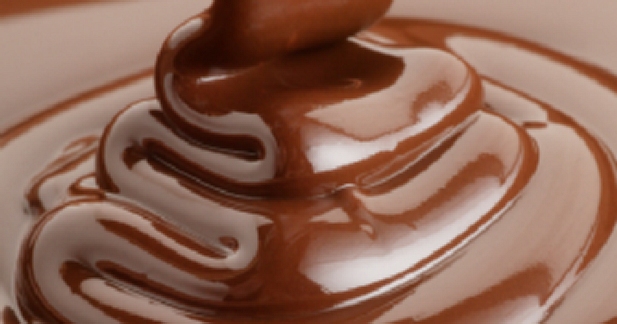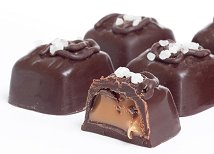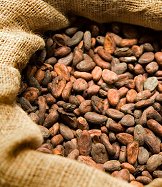chocolate education
Breyers All Natural Chocolate Ice Cream
September 20, 2010

I was intrigued. My scientific self pondered what kind of formulation adjustments had to be made to compensate for the increase in pH from the cocoa (“dutch” means processed with alkali). Don’t laugh, my brain works differently.
I have mentioned in past blog posts why it is necessary to add a Dutch-Processed or Alkalized Processed cocoa powder to dairy products like ice cream and milk. Dutch cocoa is treated with an alkali to neutralize its acids. Acidity has a negative effect on diary – it causes it to curdle.
Read more
Chocolate Label – What Does It Mean?
September 16, 2010
I am a label reader. In fact, I judiciously read labels because it is a matter of life or death for my daughter who has serious food allergies. But just because I read labels doesn’t mean I understand everything on them!
Luckily, I have experience understanding what’s on a chocolate label. When I was developing product for a large chocolate manufacturer, part of my job was to create the labels that went on our chocolates.
So, what exactly are things like “chocolate liquor,” “cocoa butter,” “soya lecithin,” or “butter fat” (by the way, isn’t butter fat a bit redundant)?
Read more
Does Chocolate Give You Acne?
September 9, 2010
How did a link between chocolate and pimples come to be? From what I can tell by reading some of the history behind chocolate health myths is that people assumed that acne was caused by eating too much fat and since chocolate has a high fat content, chocolate caused acne.
While I find this sort of logic laughable, plenty of 1950’s dermatology books put it in print as fact.
Over the years, many foods have been blamed for certain ailments and afflictions. Chocolate has been singled out to cause such things as tooth decay, acne, obesity, and depression. But chocolate by itself doesn’t cause these problems. No single food does.
Read more
The Secret (and Science) of Ice Cream Coatings
September 2, 2010
There are two basic types of chocolate ice cream coatings, “real” chocolate coatings and chocolate flavored compound or confectionery coatings.
Both types of coatings must be thin enough to cover and bend over the ice cream, thick enough not to crack open and let the ice cream seep through, and simultaneously be crunchy and melt in your mouth. That’s not asking too much, is it?
Most of these demands have to be met by the fat system used in the coating.
Read more
Fermenting Cocoa Beans
August 26, 2010
Did you know that one the most important steps in making chocolate taste like chocolate is cocoa bean fermentation?
Cocoa beans grow inside a thick-walled pod surrounded by a sugary pulp that provides nutrients to the beans (seeds). The pulp is made up of about 12% sucrose which gets broken down by microbes, mostly yeasts.
During the harvest, pods are cut down from the tree, opened, and the cocoa beans scooped out by hand. Large mounds or heaps of pulp and beans are built in order to start the fermentation process. To speed things along, big leaves (like banana) are used to cover the heaps in order to seal in the heat generated by the microbial action.
The temperature can reach 40C to 50C in the fermentation heap. Many chemical reactions take place, and it is here during fermentation that chocolate acquires its color and flavor.
Read more

Lecithin in Chocolate
August 22, 2010
Take a look at an ingredient label on a bar of chocolate. 9 times out of 10 you will see soy lecithin listed there.
Is using lecithin as an ingredient in chocolate important, and what is the benefit of using it?
How Much Caffeine is in Chocolate?
August 15, 2010
I can’t talk about caffeine without mentioning another similar chemical called theobromine. So, I’ll discuss both and even compare some things between them.
There are two chemicals present in chocolate that qualify as stimulants (alkaloid molecules known as methylxanthines), caffeine and theobromine. Theobromine affects people in a similar way to caffeine but is much weaker. Although there is significantly more theobromine in chocolate than caffeine, it triggers these “caffeine affects” on a much smaller scale.
Read more
Working With Chocolate and Caramel Filling
August 8, 2010

It is true that even the smallest amount of water and chocolate don’t get along. The combination often leads to problems like seizing and sugar bloom. Yet, you can buy chocolate-covered caramels and see for yourself that they look good and tastes good. They have a fairly decent shelf life, too.
Read more
Categories of Cocoa Beans
August 5, 2010
The chocolate world divides cocoa beans into two general categories: Flavor Beans (varieties Criollo or Trinitario) and Bulk Beans (variety Forestero).

The percentage of flavor beans in the total world production of cocoa beans is only around 5% per year. Virtually all the cocoa harvested is classified as bulk cocoa.
Read more


